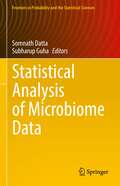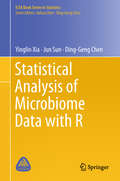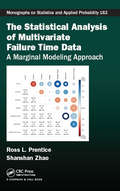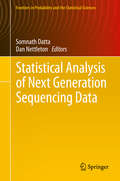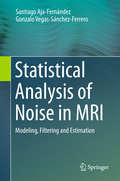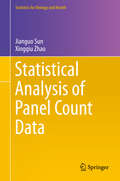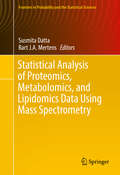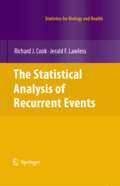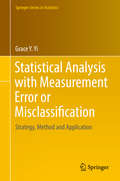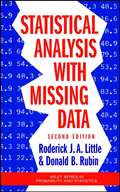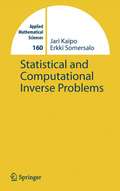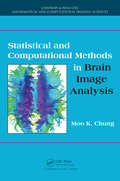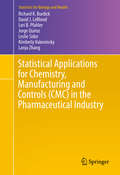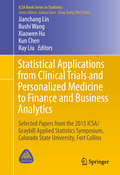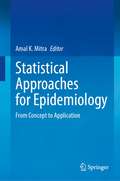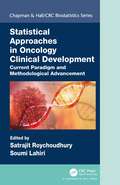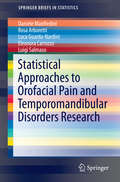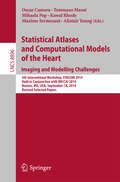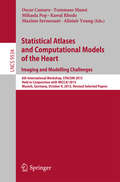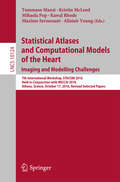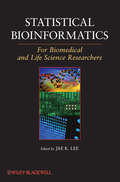- Table View
- List View
Statistical Analysis of Microbiome Data (Frontiers in Probability and the Statistical Sciences)
by Somnath Datta Subharup GuhaMicrobiome research has focused on microorganisms that live within the human body and their effects on health. During the last few years, the quantification of microbiome composition in different environments has been facilitated by the advent of high throughput sequencing technologies. The statistical challenges include computational difficulties due to the high volume of data; normalization and quantification of metabolic abundances, relative taxa and bacterial genes; high-dimensionality; multivariate analysis; the inherently compositional nature of the data; and the proper utilization of complementary phylogenetic information. This has resulted in an explosion of statistical approaches aimed at tackling the unique opportunities and challenges presented by microbiome data. This book provides a comprehensive overview of the state of the art in statistical and informatics technologies for microbiome research. In addition to reviewing demonstrably successful cutting-edge methods, particular emphasis is placed on examples in R that rely on available statistical packages for microbiome data. With its wide-ranging approach, the book benefits not only trained statisticians in academia and industry involved in microbiome research, but also other scientists working in microbiomics and in related fields.
Statistical Analysis of Microbiome Data with R (ICSA Book Series in Statistics)
by Yinglin Xia Jun Sun Ding-Geng ChenThis unique book addresses the statistical modelling and analysis of microbiome data using cutting-edge R software. It includes real-world data from the authors’ research and from the public domain, and discusses the implementation of R for data analysis step by step. The data and R computer programs are publicly available, allowing readers to replicate the model development and data analysis presented in each chapter, so that these new methods can be readily applied in their own research. The book also discusses recent developments in statistical modelling and data analysis in microbiome research, as well as the latest advances in next-generation sequencing and big data in methodological development and applications. This timely book will greatly benefit all readers involved in microbiome, ecology and microarray data analyses, as well as other fields of research.
The Statistical Analysis of Multivariate Failure Time Data: A Marginal Modeling Approach (Chapman & Hall/CRC Monographs on Statistics and Applied Probability #1)
by Ross L. Prentice Shanshan ZhaoThe Statistical Analysis of Multivariate Failure Time Data: A Marginal Modeling Approach provides an innovative look at methods for the analysis of correlated failure times. The focus is on the use of marginal single and marginal double failure hazard rate estimators for the extraction of regression information. For example, in a context of randomized trial or cohort studies, the results go beyond that obtained by analyzing each failure time outcome in a univariate fashion. The book is addressed to researchers, practitioners, and graduate students, and can be used as a reference or as a graduate course text. Much of the literature on the analysis of censored correlated failure time data uses frailty or copula models to allow for residual dependencies among failure times, given covariates. In contrast, this book provides a detailed account of recently developed methods for the simultaneous estimation of marginal single and dual outcome hazard rate regression parameters, with emphasis on multiplicative (Cox) models. Illustrations are provided of the utility of these methods using Women’s Health Initiative randomized controlled trial data of menopausal hormones and of a low-fat dietary pattern intervention. As byproducts, these methods provide flexible semiparametric estimators of pairwise bivariate survivor functions at specified covariate histories, as well as semiparametric estimators of cross ratio and concordance functions given covariates. The presentation also describes how these innovative methods may extend to handle issues of dependent censorship, missing and mismeasured covariates, and joint modeling of failure times and covariates, setting the stage for additional theoretical and applied developments. This book extends and continues the style of the classic Statistical Analysis of Failure Time Data by Kalbfleisch and Prentice. Ross L. Prentice is Professor of Biostatistics at the Fred Hutchinson Cancer Research Center and University of Washington in Seattle, Washington. He is the recipient of COPSS Presidents and Fisher awards, the AACR Epidemiology/Prevention and Team Science awards, and is a member of the National Academy of Medicine. Shanshan Zhao is a Principal Investigator at the National Institute of Environmental Health Sciences in Research Triangle Park, North Carolina.
The Statistical Analysis of Multivariate Failure Time Data: A Marginal Modeling Approach (Chapman & Hall/CRC Monographs on Statistics and Applied Probability #1)
by Ross L. Prentice Shanshan ZhaoThe Statistical Analysis of Multivariate Failure Time Data: A Marginal Modeling Approach provides an innovative look at methods for the analysis of correlated failure times. The focus is on the use of marginal single and marginal double failure hazard rate estimators for the extraction of regression information. For example, in a context of randomized trial or cohort studies, the results go beyond that obtained by analyzing each failure time outcome in a univariate fashion. The book is addressed to researchers, practitioners, and graduate students, and can be used as a reference or as a graduate course text. Much of the literature on the analysis of censored correlated failure time data uses frailty or copula models to allow for residual dependencies among failure times, given covariates. In contrast, this book provides a detailed account of recently developed methods for the simultaneous estimation of marginal single and dual outcome hazard rate regression parameters, with emphasis on multiplicative (Cox) models. Illustrations are provided of the utility of these methods using Women’s Health Initiative randomized controlled trial data of menopausal hormones and of a low-fat dietary pattern intervention. As byproducts, these methods provide flexible semiparametric estimators of pairwise bivariate survivor functions at specified covariate histories, as well as semiparametric estimators of cross ratio and concordance functions given covariates. The presentation also describes how these innovative methods may extend to handle issues of dependent censorship, missing and mismeasured covariates, and joint modeling of failure times and covariates, setting the stage for additional theoretical and applied developments. This book extends and continues the style of the classic Statistical Analysis of Failure Time Data by Kalbfleisch and Prentice. Ross L. Prentice is Professor of Biostatistics at the Fred Hutchinson Cancer Research Center and University of Washington in Seattle, Washington. He is the recipient of COPSS Presidents and Fisher awards, the AACR Epidemiology/Prevention and Team Science awards, and is a member of the National Academy of Medicine. Shanshan Zhao is a Principal Investigator at the National Institute of Environmental Health Sciences in Research Triangle Park, North Carolina.
Statistical Analysis of Next Generation Sequencing Data (Frontiers in Probability and the Statistical Sciences)
by Somnath Datta Dan NettletonNext Generation Sequencing (NGS) is the latest high throughput technology to revolutionize genomic research. NGS generates massive genomic datasets that play a key role in the big data phenomenon that surrounds us today. To extract signals from high-dimensional NGS data and make valid statistical inferences and predictions, novel data analytic and statistical techniques are needed. This book contains 20 chapters written by prominent statisticians working with NGS data. The topics range from basic preprocessing and analysis with NGS data to more complex genomic applications such as copy number variation and isoform expression detection. Research statisticians who want to learn about this growing and exciting area will find this book useful. In addition, many chapters from this book could be included in graduate-level classes in statistical bioinformatics for training future biostatisticians who will be expected to deal with genomic data in basic biomedical research, genomic clinical trials and personalized medicine.About the editors:Somnath Datta is Professor and Vice Chair of Bioinformatics and Biostatistics at the University of Louisville. He is Fellow of the American Statistical Association, Fellow of the Institute of Mathematical Statistics and Elected Member of the International Statistical Institute. He has contributed to numerous research areas in Statistics, Biostatistics and Bioinformatics.Dan Nettleton is Professor and Laurence H. Baker Endowed Chair of Biological Statistics in the Department of Statistics at Iowa State University. He is Fellow of the American Statistical Association and has published research on a variety of topics in statistics, biology and bioinformatics.
Statistical Analysis of Noise in MRI: Modeling, Filtering and Estimation
by Santiago Aja-Fernández Gonzalo Vegas-Sánchez-FerreroThis unique text presents a comprehensive review of methods for modeling signal and noise in magnetic resonance imaging (MRI), providing a systematic study, classifying and comparing the numerous and varied estimation and filtering techniques. Features: provides a complete framework for the modeling and analysis of noise in MRI, considering different modalities and acquisition techniques; describes noise and signal estimation for MRI from a statistical signal processing perspective; surveys the different methods to remove noise in MRI acquisitions from a practical point of view; reviews different techniques for estimating noise from MRI data in single- and multiple-coil systems for fully sampled acquisitions; examines the issue of noise estimation when accelerated acquisitions are considered, and parallel imaging methods are used to reconstruct the signal; includes appendices covering probability density functions, combinations of random variables used to derive estimators, and useful MRI datasets.
Statistical Analysis of Panel Count Data (Statistics for Biology and Health #80)
by Jianguo Sun Xingqiu ZhaoPanel count data occur in studies that concern recurrent events, or event history studies, when study subjects are observed only at discrete time points. By recurrent events, we mean the event that can occur or happen multiple times or repeatedly. Examples of recurrent events include disease infections, hospitalizations in medical studies, warranty claims of automobiles or system break-downs in reliability studies. In fact, many other fields yield event history data too such as demographic studies, economic studies and social sciences. For the cases where the study subjects are observed continuously, the resulting data are usually referred to as recurrent event data.This book collects and unifies statistical models and methods that have been developed for analyzing panel count data. It provides the first comprehensive coverage of the topic. The main focus is on methodology, but for the benefit of the reader, the applications of the methods to real data are also discussed along with numerical calculations. There exists a great deal of literature on the analysis of recurrent event data. This book fills the void in the literature on the analysis of panel count data.This book provides an up-to-date reference for scientists who are conducting research on the analysis of panel count data. It will also be instructional for those who need to analyze panel count data to answer substantive research questions. In addition, it can be used as a text for a graduate course in statistics or biostatistics that assumes a basic knowledge of probability and statistics.
Statistical Analysis of Proteomics, Metabolomics, and Lipidomics Data Using Mass Spectrometry (Frontiers in Probability and the Statistical Sciences)
by Susmita Datta Bart J. MertensThis book presents an overview of computational and statistical design and analysis of mass spectrometry-based proteomics, metabolomics, and lipidomics data. This contributed volume provides an introduction to the special aspects of statistical design and analysis with mass spectrometry data for the new omic sciences. The text discusses common aspects of design and analysis between and across all (or most) forms of mass spectrometry, while also providing special examples of application with the most common forms of mass spectrometry. Also covered are applications of computational mass spectrometry not only in clinical study but also in the interpretation of omics data in plant biology studies.Omics research fields are expected to revolutionize biomolecular research by the ability to simultaneously profile many compounds within either patient blood, urine, tissue, or other biological samples. Mass spectrometry is one of the key analytical techniques used in these new omic sciences. Liquid chromatography mass spectrometry, time-of-flight data, and Fourier transform mass spectrometry are but a selection of the measurement platforms available to the modern analyst. Thus in practical proteomics or metabolomics, researchers will not only be confronted with new high dimensional data types—as opposed to the familiar data structures in more classical genomics—but also with great variation between distinct types of mass spectral measurements derived from different platforms, which may complicate analyses, comparison, and interpretation of results.
The Statistical Analysis of Recurrent Events (Statistics for Biology and Health)
by Richard J. Cook Jerald LawlessThis book presents models and statistical methods for the analysis of recurrent event data. The authors provide broad, detailed coverage of the major approaches to analysis, while emphasizing the modeling assumptions that they are based on. More general intensity-based models are also considered, as well as simpler models that focus on rate or mean functions. Parametric, nonparametric and semiparametric methodologies are all covered, with procedures for estimation, testing and model checking.
Statistical Analysis with Measurement Error or Misclassification: Strategy, Method and Application (Springer Series in Statistics)
by Grace Y. YiThis monograph on measurement error and misclassification covers a broad range of problems and emphasizes unique features in modeling and analyzing problems arising from medical research and epidemiological studies. Many measurement error and misclassification problems have been addressed in various fields over the years as well as with a wide spectrum of data, including event history data (such as survival data and recurrent event data), correlated data (such as longitudinal data and clustered data), multi-state event data, and data arising from case-control studies. Statistical Analysis with Measurement Error or Misclassification: Strategy, Method and Application brings together assorted methods in a single text and provides an update of recent developments for a variety of settings. Measurement error effects and strategies of handling mismeasurement for different models are closely examined in combination with applications to specific problems.Readers with diverse backgrounds and objectives can utilize this text. Familiarity with inference methods—such as likelihood and estimating function theory—or modeling schemes in varying settings—such as survival analysis and longitudinal data analysis—can result in a full appreciation of the material, but it is not essential since each chapter provides basic inference frameworks and background information on an individual topic to ease the access of the material. The text is presented in a coherent and self-contained manner and highlights the essence of commonly used modeling and inference methods.This text can serve as a reference book for researchers interested in statistical methodology for handling data with measurement error or misclassification; as a textbook for graduate students, especially for those majoring in statistics and biostatistics; or as a book for applied statisticians whose interest focuses on analysis of error-contaminated data.Grace Y. Yi is Professor of Statistics and University Research Chair at the University of Waterloo. She is the 2010 winner of the CRM-SSC Prize, an honor awarded in recognition of a statistical scientist's professional accomplishments in research during the first 15 years after having received a doctorate. She is a Fellow of the American Statistical Association and an Elected Member of the International Statistical Institute.
Statistical Analysis with Missing Data (Wiley Series in Probability and Statistics #333)
by Roderick J. Little Donald B. Rubin* Emphasizes the latest trends in the field. * Includes a new chapter on evolving methods. * Provides updated or revised material in most of the chapters.
Statistical Analysis with Missing Data (Wiley Series in Probability and Statistics #333)
by Roderick J. Little Donald B. Rubin* Emphasizes the latest trends in the field. * Includes a new chapter on evolving methods. * Provides updated or revised material in most of the chapters.
Statistical and Computational Inverse Problems (Applied Mathematical Sciences #160)
by Jari Kaipio E. SomersaloThis book covers the statistical mechanics approach to computational solution of inverse problems, an innovative area of current research with very promising numerical results. The techniques are applied to a number of real world applications such as limited angle tomography, image deblurring, electical impedance tomography, and biomagnetic inverse problems. Contains detailed examples throughout and includes a chapter on case studies where such methods have been implemented in biomedical engineering.
Statistical and Computational Methods in Brain Image Analysis
by Moo K. ChungThe massive amount of nonstandard high-dimensional brain imaging data being generated is often difficult to analyze using current techniques. This challenge in brain image analysis requires new computational approaches and solutions. But none of the research papers or books in the field describe the quantitative techniques with detailed illustratio
Statistical Applications for Chemistry, Manufacturing and Controls (Statistics for Biology and Health)
by Richard K. Burdick David J. LeBlond Lori B. Pfahler Jorge Quiroz Leslie Sidor Kimberly Vukovinsky Lanju ZhangThis book examines statistical techniques that are critically important to Chemistry, Manufacturing, and Control (CMC) activities. Statistical methods are presented with a focus on applications unique to the CMC in the pharmaceutical industry. The target audience consists of statisticians and other scientists who are responsible for performing statistical analyses within a CMC environment. Basic statistical concepts are addressed in Chapter 2 followed by applications to specific topics related to development and manufacturing. The mathematical level assumes an elementary understanding of statistical methods. The ability to use Excel or statistical packages such as Minitab, JMP, SAS, or R will provide more value to the reader.The motivation for this book came from an American Association of Pharmaceutical Scientists (AAPS) short course on statistical methods applied to CMC applications presented by four of the authors. One of the course participants asked us for a good reference book, and the only book recommended was written over 20 years ago by Chow and Liu (1995). We agreed that a more recent book would serve a need in our industry. Since we began this project, an edited book has been published on the same topic by Zhang (2016). The chapters in Zhang discuss statistical methods for CMC as well as drug discovery and nonclinical development. We believe our book complements Zhang by providing more detailed statistical analyses and examples.
Statistical Applications from Clinical Trials and Personalized Medicine to Finance and Business Analytics: Selected Papers from the 2015 ICSA/Graybill Applied Statistics Symposium, Colorado State University, Fort Collins (ICSA Book Series in Statistics)
by Jianchang Lin Bushi Wang Xiaowen Hu Kun Chen Ray LiuThe papers in this volume represent a broad, applied swath of advanced contributions to the 2015 ICSA/Graybill Applied Statistics Symposium of the International Chinese Statistical Association, held at Colorado State University in Fort Collins. The contributions cover topics that range from statistical applications in business and finance to applications in clinical trials and biomarker analysis. Each papers was peer-reviewed by at least two referees and also by an editor. The conference was attended by over 400 participants from academia, industry, and government agencies around the world, including from North America, Asia, and Europe.
Statistical Approaches for Epidemiology: From Concept to Application
by Amal K. MitraThis textbook provides the basic concepts of epidemiology while preparing readers with the skills of applying statistical tools in real-life situations. Students, in general, struggle with statistical theories and their practical applications. This book makes statistical concepts easy to understand by focusing on real-life examples, case studies, and exercises. It also provides step-by-step guides for data analysis and interpretation using standard statistical software such as SPSS, SAS, R, Python, and GIS as appropriate, illustrating the concepts.Through the book's 23 chapters, readers primarily learn how to apply statistical methods in epidemiological studies and problem-solving. Among the topics covered:Clinical TrialsEpidemic Investigation and ControlGeospatial Applications in EpidemiologySurvival Analysis and Applications Using SAS and SPSSSystematic Review and Meta-Analysis: Evidence-based Decision-Making in Public HealthMissing Data Imputation: A Practical Guide Artificial Intelligence and Machine LearningMultivariate Linear Regression and Logistics Regression Analysis Using SASEach chapter is written by eminent scientists and experts worldwide, including contributors from institutions in the United States, Canada, Bangladesh, India, Hong Kong, Malaysia, and the Middle East. Statistical Approaches for Epidemiology: From Concept to Application is an all-in-one book that serves as an essential text for graduate students, faculty, instructors, and researchers in public health and other branches of health sciences, as well as a useful resource for health researchers in industry, public health and health department professionals, health practitioners, and health research organizations and non-governmental organizations. The book also will be helpful for graduate students and faculty in related disciplines such as data science, nursing, social work, environmental health, occupational health, computer science, statistics, and biology.
Statistical Approaches in Oncology Clinical Development: Current Paradigm and Methodological Advancement (Chapman & Hall/CRC Biostatistics Series)
by Satrajit Roychoudhury Soumi LahiriStatistical Approaches in Oncology Clinical Development : Current Paradigm and Methodological Advancement presents an overview of statistical considerations in oncology clinical trials, both early and late phase of development. It illustrates how novel statistical methods can enrich the design and analysis of modern oncology trials. The authors include many relevant real life examples from the pharmaceutical industry and academia based on their first-hand experience. Along with relevant references, the book highlights current regulatory views. The book covers all aspects of cancer clinical trial starting from early phase development. The early part of the book covers novel phase I dose escalation design, exposure response analysis, and innovative phase II design. This includes early development strategy for cancer immunotherapy trials. The contributors also emphasized the role of biomarker and modern era of precision medicine. The second part focuses on the late stage development. This includes the application of adaptive design, safety analysis, and quality of life (QoL) data analysis. The final part discusses current regulatory perspective and challenges. Features: Covers a wide spectrum of topics related to real-life statistical challenges in oncology clinical trials. Provides a comprehensive overview of novel statistical methods to improve trial design and statistical analysis. Detailed case studies illustrate the real life applications. Satrajit Roychoudhury is a Senior Director and a member of the Statistical Research and Innovation group in Pfizer Inc. Prior to joining; he was a member of Statistical Methodology and consulting group in Novartis. He has 11 years of extensive experience in working with different phases of clinical trial. His area of research includes early phase oncology trials, survival analysis, model informed drug development, and use of Bayesian methods in clinical trials. He is industry co-chair for the ASA Biopharmaceutical Section Regulatory-Industry Workshop and has provided statistical training in major conferences including the Joint Statistical Meetings, ASA Biopharmaceutical Section Regulatory-Industry Workshop, and ICSA Applied Statistics Symposium. Soumi Lahiri has 12 years of extensive experience in working different therapeutic areas. She is the former Director of Biostatistics in Clinical Oncology, GlaxoSmithKline. She has also worked in the oncology division of Novartis Pharmaceutical Company for two years. She is an active member of the ASA Biopharmaceutical section and former chair of the membership committee.
Statistical Approaches in Oncology Clinical Development: Current Paradigm and Methodological Advancement (Chapman & Hall/CRC Biostatistics Series)
by Satrajit Roychoudhury Soumi LahiriStatistical Approaches in Oncology Clinical Development : Current Paradigm and Methodological Advancement presents an overview of statistical considerations in oncology clinical trials, both early and late phase of development. It illustrates how novel statistical methods can enrich the design and analysis of modern oncology trials. The authors include many relevant real life examples from the pharmaceutical industry and academia based on their first-hand experience. Along with relevant references, the book highlights current regulatory views. The book covers all aspects of cancer clinical trial starting from early phase development. The early part of the book covers novel phase I dose escalation design, exposure response analysis, and innovative phase II design. This includes early development strategy for cancer immunotherapy trials. The contributors also emphasized the role of biomarker and modern era of precision medicine. The second part focuses on the late stage development. This includes the application of adaptive design, safety analysis, and quality of life (QoL) data analysis. The final part discusses current regulatory perspective and challenges. Features: Covers a wide spectrum of topics related to real-life statistical challenges in oncology clinical trials. Provides a comprehensive overview of novel statistical methods to improve trial design and statistical analysis. Detailed case studies illustrate the real life applications. Satrajit Roychoudhury is a Senior Director and a member of the Statistical Research and Innovation group in Pfizer Inc. Prior to joining; he was a member of Statistical Methodology and consulting group in Novartis. He has 11 years of extensive experience in working with different phases of clinical trial. His area of research includes early phase oncology trials, survival analysis, model informed drug development, and use of Bayesian methods in clinical trials. He is industry co-chair for the ASA Biopharmaceutical Section Regulatory-Industry Workshop and has provided statistical training in major conferences including the Joint Statistical Meetings, ASA Biopharmaceutical Section Regulatory-Industry Workshop, and ICSA Applied Statistics Symposium. Soumi Lahiri has 12 years of extensive experience in working different therapeutic areas. She is the former Director of Biostatistics in Clinical Oncology, GlaxoSmithKline. She has also worked in the oncology division of Novartis Pharmaceutical Company for two years. She is an active member of the ASA Biopharmaceutical section and former chair of the membership committee.
Statistical Approaches to Orofacial Pain and Temporomandibular Disorders Research (SpringerBriefs in Statistics)
by Daniele Manfredini Rosa Arboretti Luca Guarda Nardini Eleonora Carrozzo Luigi SalmasoThis book covers some biostatistical methods and several case studies useful to interpret and analyze dental research in the areas of orofacial pain and temporomandibular disorders. It will guide practitioners in these fields who would like to interpret research findings or find examples on the design of clinical investigations. After an introduction dealing with the basic issues, the central sections of the textbook are dedicated to the different types of investigations in sight of specific goals researchers may have. The final section contains a recent approach based on nonparametric permutation tests which can be adopted in many practical situations. The field of orofacial pain and temporomandibular disorders is emerging as one of the most critical areas of clinical research in dentistry. Due to the complexity of clinical pictures, the multifactorial etiology, and the importance of psychosocial factors in all aspects of the TMD practice, clinicians often find it hard to appraise their modus operandi, and researchers must constantly increase their knowledge in epidemiology and medical statistics. Indeed, proper methodological designs are fundamental to reaching high levels of internal and external validity of findings in this specific area.
Statistical Atlases and Computational Models of the Heart: 5th International Workshop, STACOM 2014, Held in Conjunction with MICCAI 2014, Boston, MA, USA, September 18, 2014, Revised Selected Papers (Lecture Notes in Computer Science #8896)
by Oscar Camara Tommaso Mansi Mihaela Pop Kawal Rhode Maxime Sermesant Alistair YoungThis book constitutes the thoroughly refereed post-conference proceedings of the 5th International Workshop on Statistical Atlases and Computational Models of the Heart: Imaging and Modelling Challenges, STACOM 2014, held in conjunction with MICCAI 2014, in Boston, MA, USA, in September 2014. The 30 revised full papers were carefully reviewed and selected from numerous submissions. The papers cover a wide range of topics such as sections on cardiac image processing; atlas construction; statistical modelling of cardiac function across different patient populations; cardiac mapping; cardiac computational physiology; model customization; atlas based functional analysis; ontological schemata for data and results; integrated functional and structural analyses; as well as the pre-clinical and clinical applicability of these methods.
Statistical Atlases and Computational Models of the Heart. Imaging and Modelling Challenges: 6th International Workshop, STACOM 2015, Held in Conjunction with MICCAI 2015, Munich, Germany, October 9, 2015, Revised Selected Papers (Lecture Notes in Computer Science #9534)
by Oscar Camara Tommaso Mansi Mihaela Pop Kawal Rhode Maxime Sermesant Alistair YoungThis book constitutes the thoroughly refereed post-workshop proceedings of the 6th International Workshop on Statistical Atlases and Computational Models of the Heart: Imaging and Modelling Challenges, STACOM 2015, held in conjunction with MICCAI 2015, in Munich, Germany, in October 2015. The 23 revised full workshop papers were carefully reviewed and selected from 34 submissions. The papers cover a wide range of topics such cardiac image processing, atlas construction, statistical modeling of cardiac function across different patient populations, cardiac mapping, cardiac computational physiology, model customization, image-based modelling and image-guided interventional procedures, atlas based functional analysis, ontological schemata for data and results, integrated functional and structural analysis.
Statistical Atlases and Computational Models of the Heart. Imaging and Modelling Challenges: 7th International Workshop, STACOM 2016, Held in Conjunction with MICCAI 2016, Athens, Greece, October 17, 2016, Revised Selected Papers (Lecture Notes in Computer Science #10124)
by Tommaso Mansi Kristin McLeod Mihaela Pop Kawal Rhode Maxime Sermesant Alistair YoungThis book constitutes the thoroughly refereed post-workshop proceedings of the 7th International Workshop on Statistical Atlases and Computational Models of the Heart: Imaging and Modelling Challenges. 7th International Workshop, STACOM 2016, Held in conjunction with MICCAI 2016, Athens, Greece, October 17, 2016, Revised Selected papers The 24 revised full workshop papers were carefully reviewed and selected from 32 submissions. The papers cover a wide range of topics such as cardiac image processing; atlas construction, statistical modelling of cardiac function across different patient populations; cardiac mapping, cardiac computational physiology; model customization; image-based modelling and image-guided interventional procedures; atlas based functional analysis, ontological schemata for data and results; integrated functional and structural analyses; pre-clinical and clinical applicability of the methods described.
Statistical Bioinformatics: For Biomedical and Life Science Researchers
by Jae K. LeeThis book provides an essential understanding of statistical concepts necessary for the analysis of genomic and proteomic data using computational techniques. The author presents both basic and advanced topics, focusing on those that are relevant to the computational analysis of large data sets in biology. Chapters begin with a description of a statistical concept and a current example from biomedical research, followed by more detailed presentation, discussion of limitations, and problems. The book starts with an introduction to probability and statistics for genome-wide data, and moves into topics such as clustering, classification, multi-dimensional visualization, experimental design, statistical resampling, and statistical network analysis. Clearly explains the use of bioinformatics tools in life sciences research without requiring an advanced background in math/statistics Enables biomedical and life sciences researchers to successfully evaluate the validity of their results and make inferences Enables statistical and quantitative researchers to rapidly learn novel statistical concepts and techniques appropriate for large biological data analysis Carefully revisits frequently used statistical approaches and highlights their limitations in large biological data analysis Offers programming examples and datasets Includes chapter problem sets, a glossary, a list of statistical notations, and appendices with references to background mathematical and technical material Features supplementary materials, including datasets, links, and a statistical package available online Statistical Bioinformatics is an ideal textbook for students in medicine, life sciences, and bioengineering, aimed at researchers who utilize computational tools for the analysis of genomic, proteomic, and many other emerging high-throughput molecular data. It may also serve as a rapid introduction to the bioinformatics science for statistical and computational students and audiences who have not experienced such analysis tasks before.
Statistical Bioinformatics: For Biomedical and Life Science Researchers
by Jae K. LeeThis book provides an essential understanding of statistical concepts necessary for the analysis of genomic and proteomic data using computational techniques. The author presents both basic and advanced topics, focusing on those that are relevant to the computational analysis of large data sets in biology. Chapters begin with a description of a statistical concept and a current example from biomedical research, followed by more detailed presentation, discussion of limitations, and problems. The book starts with an introduction to probability and statistics for genome-wide data, and moves into topics such as clustering, classification, multi-dimensional visualization, experimental design, statistical resampling, and statistical network analysis. Clearly explains the use of bioinformatics tools in life sciences research without requiring an advanced background in math/statistics Enables biomedical and life sciences researchers to successfully evaluate the validity of their results and make inferences Enables statistical and quantitative researchers to rapidly learn novel statistical concepts and techniques appropriate for large biological data analysis Carefully revisits frequently used statistical approaches and highlights their limitations in large biological data analysis Offers programming examples and datasets Includes chapter problem sets, a glossary, a list of statistical notations, and appendices with references to background mathematical and technical material Features supplementary materials, including datasets, links, and a statistical package available online Statistical Bioinformatics is an ideal textbook for students in medicine, life sciences, and bioengineering, aimed at researchers who utilize computational tools for the analysis of genomic, proteomic, and many other emerging high-throughput molecular data. It may also serve as a rapid introduction to the bioinformatics science for statistical and computational students and audiences who have not experienced such analysis tasks before.
